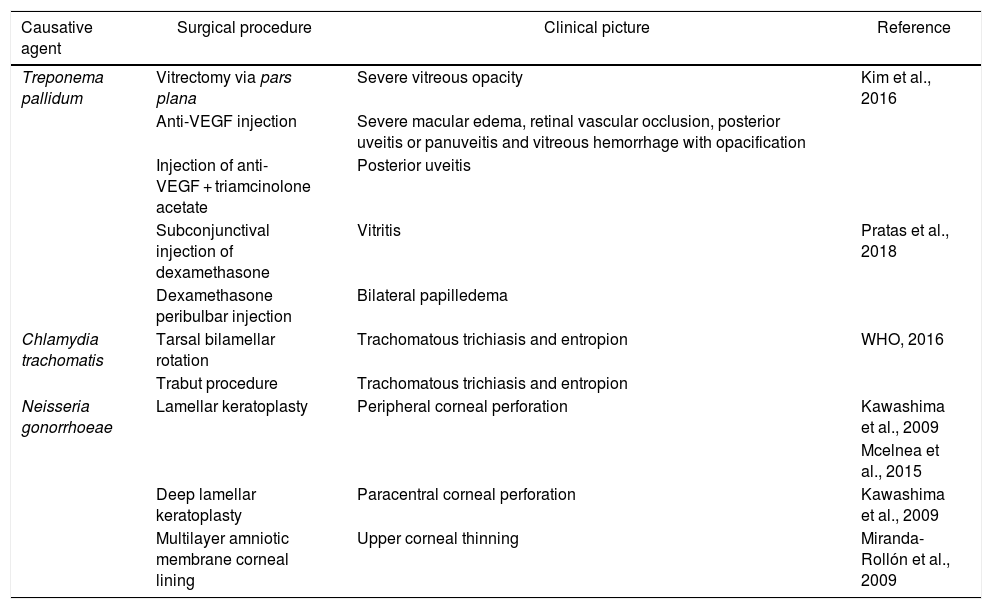The objective of this work was to collect updated information on Treponema pallidum, Chlamydia trachomatis and Neisseria gonorrhoeae, causing sexually transmitted infections (STIs) and etiological agents of eye infections, to provide relevant information on this public health problem. For this, a bibliographic review was carried out using different electronic databases such as: PubMed central, google academic, Lilacs, Scopus, Science Direct and Scielo, between March 2009 and August 2019. According to the WHO, more than a million people a day contract a sexually transmitted infection. For T. pallidum, a global prevalence of 0.5% is estimated for both men and women. It is a causative agent of syphilis and ocular syphilis, which manifests as uveitis. Overall, a prevalence of 2.8% in men and 3.8% in women for C. trachomatis is estimated. It is associated with oculo-genital disease, which includes STIs, inclusion conjunctivitis in adults and neonatal ophthalmia. Among its complications is trachoma, which is the leading cause of infectious blindness worldwide. Regarding N. gonorrhoeae, it has a global selection of 0.9% and 0.7% in women and men, respectively. It manifests with gonococcal conjunctivitis and neonatal ophthalmia. We can conclude that the information that relates T. pallidum, C. trachomatis and N. gonorrhoeae with their ocular compromise problems is insufficient, and even more so if we seek to find them related to each other, which makes it difficult to access data of clinical utility for visual health.
El objetivo de este trabajo fue recopilar información actualizada sobre Treponema pallidum, Chlamydia trachomatis y Neisseria gonorrhoeae, como los principales agentes etiológicos de infecciones oculares asociadas con infecciones de transmisión sexual (ITS), como manera de proveer información relevante sobre este problema de salud pública. Para esto, se realizó una revisión bibliográfica utilizando diferentes bases de datos electrónicas como: PubMed Central, Google Académico, LILACS, Scopus, ScienceDirect y SciELO, entre marzo de 2009 y agosto de 2019. Según la OMS, más de un millón de personas al día contraen una infección de transmisión sexual. Para T. pallidum se estima globalmente una prevalencia de 0,5%, tanto en hombres como en mujeres. Este microorganismo es agente causal de sífilis y de sífilis ocular, que se manifiesta como uveítis. Se estima globalmente una prevalencia de 2,8% en hombres y de 3,8% en mujeres para C. trachomatis. Esta bacteria está asociada a enfermedad oculogenital, que incluye ITS, conjuntivitis de inclusión en adultos y oftalmia neonatal, dentro de sus complicaciones se encuentra el tracoma, que es la primera causa de ceguera infecciosa a nivel mundial. Respecto a N. gonorrhoeae tiene una estimación global de 0,9 y 0,7% en mujeres y hombres, respectivamente. Se manifiesta con conjuntivitis gonocócica y oftalmia neonatal. Podemos concluir que la información que relaciona a T. pallidum, C. trachomatis y N. gonorrhoeae con sus respectivos compromisos oculares es insuficiente, y aún más si buscamos encontrarlas relacionadas entre sí, lo que dificulta el acceso a datos de utilidad clínica para la salud visual.











